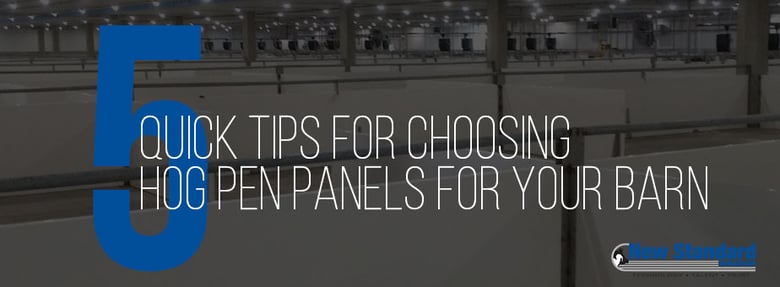
Looking to replace your current hog pen panels or putting together a new hog barn design? You have some decisions to make! Take a look at these quick tips to help you through the decision making process.
1. Install hog pen panels that are easy on your staff
When choosing paneling and gating for your swine barn, make sure it easy to work with. If the panels and gates are heavy or are designed poorly, working in your barn will be a frustrating and, at times, dangerous experience. Before putting your hog barn design or your pen plans together, consult your staff on how they would prefer your paneling and gating to operate.
2. Choose the best plastic panel for biosecurity
There are a multitude of biosecurity threats to your swine barn that you have to pay attention to. Make it one less to think about by installing hog penning that reduces the risk of infection and disease. PVC hog pen panels are extruded so they have long open channels that can trap manure inside. This manure will stay inside for the life of the panel and become a fly and mouse haven.
Well-designed polypropylene panels will be built using internal cells rather than long tubes that run all the way through the panel. The cellular structure ensures that the interior of the panel is always closed, and dirt and manure are not allowed to enter and travel through the panel.
3. Make sure your panels are easy to clean
Your hog penning should be easy to clean for both biosecurity reasons and cleaning efficiency. PVC plastic is of a loose molecular structure so bacteria and viruses can be embedded in the panel. And no matter how much you try to power wash them, diseases will lock in which will infect your pigs as they rub past.
Polypropylene on the other hand is a food grade plastic that has a tight molecular structure that pathogens cannot penetrate. This tight molecular structure makes the panels much easier to wash, and they will be disease free when washed.
4. Compare how easily panels shatter
There is no denying that pigs are massive and forceful animals. They are naturally hard on your materials and equipment, so it is valuable to know how easily different paneling materials shatter. If you buy a cheaper, weaker product, you will have to replace your hog pen panels more often, making it a more expensive option than the more expensive durable panels. In addition, when some materials shatter, they become sharp and can injure your animals before you are able to fix the panel.
All plastics can be broken if enough force is applied but every plastic has its own characteristics and operating temperatures. PVC is a naturally more brittle plastic and is prone to shattering at almost any operating temperature. Polyethylene is a great cold weather plastic and will have to be well below freezing before it become brittle enough to shatter but polyethylene will start to get soft and flexible at a lower temperature. Polypropylene will get a bit more brittle at cooler temperatures and may not be the best at subzero conditions but will maintain its strength and rigidity at much higher temperatures.
5. Beware of lesser options
In most swine barn applications, polypropylene panels are the best choice for durability, cleanliness and versatility. Even within that plastic group however, your choices are many and ever increasing.
There are two things to watch for when analyzing your options on polypropylene panels; the overall amount of plastic in the panel and the quality of the plastic itself.
The wall thickness and chamber size within a polypropylene panel can greatly impact the strength of the panel overall. A very easy measure to compare equal looking panels is to compare the weight of the different options. The weight comparison will quickly show which piece is the better option for strength.
Plastic quality is also very critical. The two most prevalent options are: “near to prime virgin material” or “recycled material”. Virgin material will always be a bit stronger as it won’t be subject to impurities. Recycled material can and is used, but when choosing the recycled option, opt for a pure and consistent color that isn’t black. Greens, blues and grays are good options, but if the panel is black and is recycled plastic, it is likely a combination from a lot of sources and is more prone to inconsistencies.
Check out our comparison of Polypropylene vs. PVC panels!





